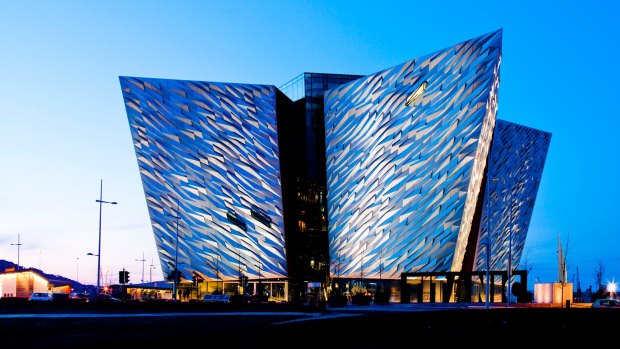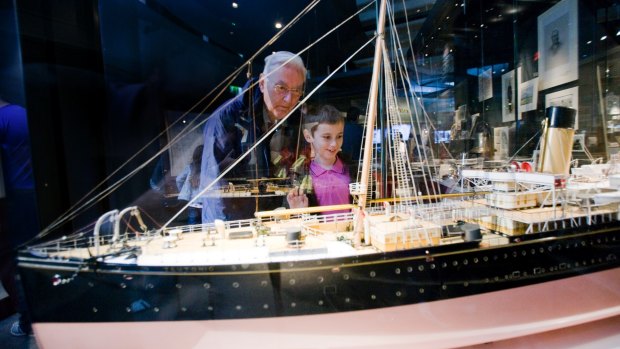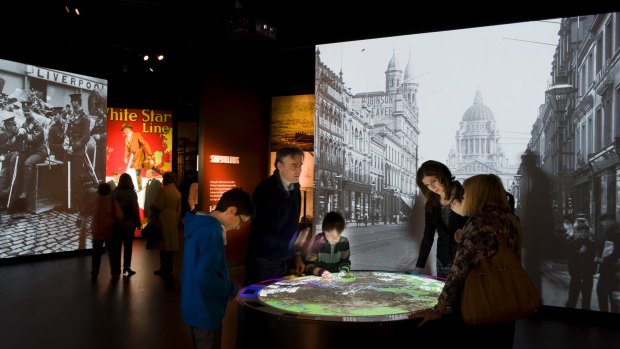This was published 5 years ago
Belfast's Titanic Museum: An ironic hit with cruise ship passengers
By Steve Meacham

Belfast's award-winning Titanic Museum.
It's a strange – but very Irish fact – that Belfast boasts not four, but at least five, separate tourism "quarters":
There's the Linen quarter, around Donegall Square, reflecting the decades in the 19th century when the Northern Irish capital was the biggest manufacturer of linen in the world.
The Cathedral quarter, around the protestant St Anne's cathedral, now home to bars and restaurants.

Once inside, don't expect the exhibits to dwell on the parts of the Titanic story you already know.
The Queen's quarter, which centres on Queen's University in south Belfast, along with the Botanic Gardens and the Ulster Museum. Plus the Gaeltacht quarter, where the Irish language is predominantly spoken (mainly along the once-infamous Falls Road).
And, of course, the Titanic quarter.
A popular T-shirt often seen on Northern Irish chests reads: "The Titanic was fine when it left Belfast!"

The museum is really an encapsulation of Belfast at the time the Titanic was being built.
But you can't help wondering why a city like Belfast, for so long associated with the tragedy born of "the Troubles" would associate itself with another pointless loss of life.
Yet the Titanic Museum has won multiple awards, not least being voted "the world's most popular tourist attraction" in 2016, beating seven other finalists, including Ferrari World Abu Dhabi, the Las Vegas Strip and Peru's Machu Picchu.
Ship 401 was built on the slipway where the museum stands today.
In 1911, when the Titanic was launched, Harland and Wolff was the largest commercial shipyard in the world. It was so big, the Titanic's smaller sister ship, Britannic, was being constructed at the same time on the neighbouring slipway with the aid of the largest gantry crane the world had ever seen.
Both ships – and their third sister, Olympic – were designed to usher in a new era of luxury travel (if you could afford it).
All three ships were designed in H & W's draughtsmen's offices, flooded with light back in the day, and now the centre point of the trendy Titanic Hotel. The entire Titanic quarter has been transformed. You only need to gaze 100 metres further north to see Titanic Studios – home to Game of Thrones, which spawned Northern Ireland's flourishing film industry.
So what of the Titanic Museum itself?
The late Texan-born architect Eric Kuhne (who also designed Sydney's Cockle Bay Wharf) created his masterpiece in Belfast. Its thrusting, triangular exterior represents the bows of the three White Star Line ships that were meant to transform Atlantic ocean crossings – long before the jet engine had been invented.
Once inside the museum, don't expect the exhibits to dwell on the parts of the Titanic story you already know.
Of course, that iceberg features, along with the "Unsinkable Molly Brown", the adulterers who died with their mistresses, and the orchestra that played on when all was doomed.
However, the Titanic Museum is really an encapsulation of Belfast at the time the Titanic was being built.
You'll learn about Belfast's pre-eminence as centre of the linen industry (and the awful working conditions women and children were subjected to).
About White Star's commercial battle with the upstart Cunard for mastery of transatlantic travel which led to the Blue Ribbon race for the fastest crossing of the Atlantic.
About the hurried trials in the Irish Sea before the Titanic steamed down to Southampton to pick up its first celebrity guest list.
And Titanic's anchorage at Cherbourg while its tender, the Normadic – the size of a Sydney ferry – crossed back and forth. (Entry to the restored Nomadic is included in the price of your entry ticket – and it's the closest you'll ever get to stepping on the class-ridden segregation championed by White Star.)
There's also superb underwater footage of Titanic as it rests today on the seabed.
Surprisingly, many overseas visitors to the Titanic Museum are cruise ship passengers.
Since the Good Friday Agreement of 1998, Belfast has become a boom city (in the best sense).
A record 117 cruise ships will dock along the Northern Irish coast in 2018. Many passengers will disembark from their modern cruise ship (almost certainly bigger than the Titanic) to experience the sinking of a ship on its maiden voyage.
The Titanic has (literally) gone down in history as a symbol of human hubris against the forces of unpredictable nature. It's a lesson we're still struggling to master a century later.
TRIP NOTES
FLY
Cathay Pacific flies from Australia to Dublin four times a week, via Hong Kong. See cathaypacific.com. Belfast is a three-hour car journey from Dublin airport.
STAY
Titanic Hotel, see titanichotelbelfast.com
TOUR
Titanic Museum, titanicbelfast.com
MORE
traveller.com.au/northern-ireland
Steve Meacham travelled as a guest of Cathay Pacific and Tourism Ireland.
Sign up for the Traveller Deals newsletter
Get exclusive travel deals delivered straight to your inbox. Sign up now.